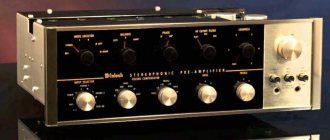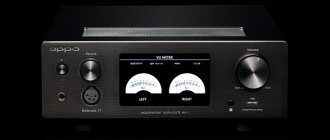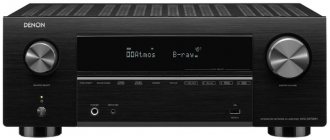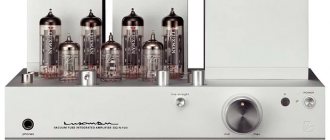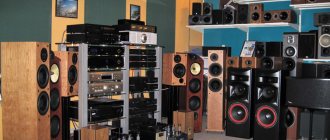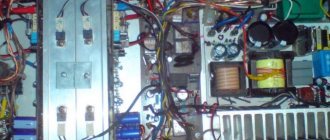Advances in digital audio technology have created a challenge for manufacturers to keep up with the times and innovate when designing integrated amplifiers.
. An example of this approach was the Rotel RA-1572 model. The classic case, advanced settings and input system are combined with high functional characteristics, performance, and excellent detailing of effects.
Features of the model in a detailed review of Rotel RA-1572
The standard equipment of the amplifier includes a modern power supply with a large transformer, which protects the device from power surges, overloads, and network interference. The toroidal core also contributes to the distortion-absorbing effect. Special storage-type capacitors with built-in T-shaped contacts maintain a stable level of current supply. The technology has a positive effect on the dynamics and natural sound of the Rotel RA-1572.
The amplifier stage is more versatile when compared with similar devices from other manufacturers. An advanced high-quality DAC chip is installed, thanks to which stable digital-to-analog signal conversion is realized. Standard parameters are 32 bit/768 kHz. Professional processing of the analog signal stream is provided. First review of the Rotel RA-1572
You can evaluate the quality of processing and verify the high parameters of the device.
- The amplifier's input stage has a large number of connectors for connecting different types of equipment. This distinguishes the model from most other analogues on the market. The built-in converter is capable of receiving a wide range of signals, efficiently processing and transmitting a music track to playback systems.
- The USB connector located on the front side of the case allows you to synchronize the device with modern music media. Remote data transfer is provided by Bluetooth with aptX support. Reviews of the Rotel RA-1572 confirm its practicality in operation and ease of entering parameters.
- Connection of streaming equipment with a resolution in the 24-bit/192 kHz range is realized through optical and coaxial inputs. Automatic volume selection is available. The mechanism is relevant for controlling the device with minimal user participation. The manufacturer has introduced additional XLR inputs.
- The output stage of the Rotel RA-1572 is equipped with discrete transistors, which allow the implementation of high detail of any signals. The device synchronizes effectively with almost any type of speaker. Power is set in the range of 120 watts per channel at a nominal impedance level of 8 ohms.
- Additionally, an output for connecting a subwoofer is integrated.
- In our review of the Rotel RA-1572, we should mention a pair of trigger outputs that allow you to control the timing of system components.
- A convenient display allows you to navigate and make custom settings. It is possible to update the firmware via the Internet. The required parameters are downloaded offline.
REPLACEMENT IN COMPOSITION
Inflation has greatly shifted the line between Hi-Fi and High End Audio. Until recently, British magazines classified equipment priced at under 1,000 pounds among the top models of “high fidelity,” but today this figure has de facto become the starting point for mid-range components. The functional complication of audio equipment also contributes to the observed rise in price. The average buyer no longer needs classic Hi-Fi - give him a built-in DAC, Bluetooth, multiroom, and other things.
On the Russian market the situation is even more gloomy. Because of the ruble exchange rate, in the segment up to 100 thousand rubles you can only catch “small fish” for your home audio - low-budget acoustics, mini-components or some kind of “advanced China”. Something decent from reputable brands, made without skimping on audiophile-grade radio components, begins to come across only when you enter a range of 200 - 400 thousand rubles in the search forms. Now it serves as “neutral waters” between classes, although it is far from a fact that above this mark you will be offered a thoroughbred High End - it could also be something purely designer.
| The revision affected the preliminary section - even more precisely selected resistors and interstage capacitors of improved quality were installed in the path. |
That is why many manufacturers who previously occupied a marginal niche have moved into a more expensive segment. Perhaps only Rotel has not abandoned attempts to produce affordable High End products. Its 15 series components - those that, before the release of the luxury Michi line, were the most representative in the model range, but were sold at a hi-fi price - are the best example of this. Take, for example, the most affordable integrated device in the series, RA-1572. How many comparable in price and at the same time really good-sounding amplifiers with a display and DAC, with a developed input selector and acoustics switch, with Bluetooth and a USB input for connecting mobile devices, with a phono preamplifier and two subwoofer outputs?
In the release of upgraded MKII amplifiers, I personally see the company’s desire to further strengthen its position in Affordable High End. Yes, these models turned out to be a little more expensive than the previous ones, although neither the design nor the functionality has changed. But this is the case when all the changes made to the design pursue only one goal - to raise the sound quality even higher.
In the RA reviewed here, 33 key elements in particular were replaced. The revision affected the preliminary section - even more precisely selected resistors and interstage capacitors of improved quality were installed in the path. The power system has been redesigned. The branded torus remains the same, and the block of buffer tanks is new - with reduced internal resistance (ESR) and an even higher discharge rate. By the way, in the first modification there were also special capacitors with T-shaped leads to the plates, but now in their place there are analogues made according to Michi specifications.
| Unlike the previously used converter from Asahi Kasei Microdevices, the new one provides hardware decoding of MQA Studio and works only with PCM stream. |
The third and rather radical replacement is a digital-to-analog converter from Texas Instruments (the chip model is not specified, but its characteristics are clearly one of the most advanced). Unlike the previously used converter from Asahi Kasei Microdevices, the new one provides hardware decoding of MQA Studio and only works with PCM streams (up to 32-bit/384 kHz). Higher is hardly required - standard inputs are designed for a maximum frequency of 192 kHz, and via USB Audio 2.0 it is impractical to transmit a signal above 384 kHz - the increased likelihood of errors offsets the benefits of wider bandwidth at extreme frequencies. And “disabling” DSD support will be considered a loss only by audiophile purists. There are still far fewer phonograms in this format than in other Hi-Res formats, and listening to them will not be a problem if the source used can output single-bit content in the traditional PCM format.
I do not rule out that someone will be skeptical about such a replacement or even consider it a downgrade. We will definitely return to examining the quality of the built-in DAC, but for now we will run the amplifier through a regular analog path.
So, at the input there is an RCD-1572 player connected via the usual “unbalance”, and two pairs of acoustics are connected to the output terminals of the amplifier for comparison - for systems A we will have relatively light, but very demanding two-way monitors B&W 705 Signature (8 Ohm), and systems B - much tighter floor-standing Dynaudio Evoke 50 (4 Ohms).
| It gives the most powerful, fast and impactful bass without viscous, sloppy after-sounds, even if you turn on both pairs at the same time! |
In any case, the upgraded amplifier copes with the load, excuse the common term, effortlessly. It gives the most powerful, fast and impactful bass without viscous, sloppy after-sounds, even if you turn on both pairs at the same time! I wonder what the even more powerful RA-1592MkII is capable of then?
As a significant plus, I note that the amplifier does not impose its interpretation and allows the speakers to fully “speak.” Paired with the relatively inexpensive Dynaudio is depth, power and a flow of warm energy. The middle is slightly darkened, the upper register is softened. The sound is filled with bass from the lowest tectonic foundations. The stage is well divided according to plans, and if the most distant echelons are recorded in the recording, then they line up exactly there - far behind the front line.
The tandem with the aesthetic “British” is clarity, super speed and rich microdynamics. The stage is wide, extremely figurative, with an open middle and upper register. Such a system is able to convey vocals in every detail, and truly shine with orchestral brass - powerfully and elegantly, but without shrill or ear-searing harmonics (however, the same fantastic tonal clarity in the most difficult to reproduce and “flammable” range was also possessed by a more expensive tandem of Michi X5 and Bowers&Wilkins 804 D3 2). The bass is a little shallow, but very punchy. The top is clean and neutral.
Now we switch to a digital coaxial connection and listen to the same CDs. By the way, the DAC in the CD player is made on a rather ancient, but quite musical chip from Wolfson, but now the path is bypassed and goes through the new DAC from TI. The difference in presentation is significant - the stage is more transparent, the plates are a little sharper and even cleaner, the middle is not so convex. There is no particular gain in either detailing or sound plasticity.
| The sound is more orderly and detailed, there is not the slightest hint of compression, and there are absolutely zero dirty “hardware” shades. |
To complete the experiment, we digitally connect the Rotel T14 streamer/tuner to listen to the same CDs, but in the form of ribbed files transmitted over the network using DTS Play-Fi. The result is surprisingly similar to the one described above - the converter from Texas Instruments gives a more transparent and dynamic sound at high frequencies.
By the way, this character is great when pairing Rotel with a smartphone via Bluetooth. With such a connection, the lowest “layer” of musical details is still “eaten up” by the codec, so there is nothing to regret, but you don’t feel any dynamic compression at all. Artifacts on HF are also invisible.
You begin to look at the RA-1572MKII with different eyes when a MacBook connected via USB becomes the source. The sound turns out to be more orderly and detailed, there is not the slightest hint of compression, and there are absolutely zero dirty “hardware” tones (let me remind you that we are not listening to the most expensive amplifier). One can only find fault with the accuracy of focusing of virtual images in the scene - for the same Michi it was sharper and more holographic.
The resolution of such a path is best evidenced by the following fact: a change in the resampling frequency at the USB output can easily be heard by ear. If the 44.1 stream is output as is or as a multiple of the value (88.1 or 176.4), then everything is fine. If you set it to 192 or 384, which require more complex recalculation, then the entire most colorful texture in the bass is slightly blurred, and a tiny addition of sonority appears on the treble.
A laptop + Roon in combination with an upgraded amplifier is an inspiration. And some things with Tidal Master in maximum MQA quality are doubly enlightening. It feels as if the recording is no longer being played in the usual stereo, but with added spatial information, in the smallest strokes. At the same time, there is a strong feeling that the entire reproductive system has grown leaps and bounds in the classroom.
But this super resolution also has a downside. On an amplifier with a new DAC, you can also clearly hear that the content that streaming services offer as the highest quality sometimes sounds no better than branded CD releases. Maybe that's why Rotel is in no hurry to introduce various streaming platforms into its components?
Why the Rotel RA-1572 amplifier is chosen by connoisseurs of the best sound
The model demonstrates high quality audio signal processing when working with any functional load. Manufacturers have introduced a flexible settings system that allows you to set custom parameters depending on the individual preferences of the music lover. The ability to synchronize with professional headphones has been implemented. Bowers Wilkins P3 review
will be an example of the use of similar equipment in practice.
The design of the Rotel RA-1572 amplifier combines traditional elements of classic design models. The design continues the traditions of the appearance of devices adopted back in the 20th century. Intuitive switches allow the user to quickly navigate and select the optimal settings configuration. The front panel is decorated with a fluorescent display. Models with black and silver body designs are available. The total weight of the amplifier is 13 kg. The device is protected from mechanical damage by a durable plastic case.
Hi-Fi Design is an excellent opportunity to purchase the Rotel RA-1572 amplifier with unique characteristics. Qualified consultants will help you understand the features of connecting the model, setting individual parameters and operation. The model will give you new impressions from professional processing of your favorite music!
We also have a review on the website that you can read: One of the best in its class: review of the Marantz HD-AMP1 amplifier and Marantz HD-CD1 player
COMPONENTS
- Vivo X50 Pro smartphone
- Apple MacBook Pro laptop
- CD player Rotel RCD-1572
- Network tuner Rotel T-14
- Headphones Audio-Technica ATH-MSR7b (36 Ohm)
- Speaker systems Bowers&Wilkins 705 Signature and Dynaudio Evoke 50
- Cables
- digital Audioquest USB Diamond and Audioquest VDM-3 75 Ohm
- interconnect RCA Luxman 1000
- acoustic Transparent Musicwave Plus (2 meters) and Super (3 meters)
Rotel RA-1572MKII
Inputs: XLR stereo pair, 3 RCA stereo pairs, Phono, 2 coaxial S/PDIF, 2 optical TOSLink, USB Type B (PCM up to 32 bit/384 kHz, DSD64, DSD128 (Native or DoP), MQA), USB Type A || Wireless connection: Bluetooth (AAC/aptX) || Input Impedance: 100 kOhm (47 kOhm on Phono MM) || Outputs: 6.3 mm jack, 2 SUB, PreOut RCA || Output power: 120/200 W (8/4 ohms) || Playback range: 10 Hz – 100 kHz (+/-0.5 dB) || RIAA Rejections: +/-0.5 dB || Signal to Noise Ratio: 100/100/80 dB (RCA/Digital/Phono) || Harmonic distortion: less than 0.018% || Intermodulation distortion: less than 0.03% || Dumping factor: 300 || Power consumption: 400 W || Dimensions (HxWxD): 144 x 431 x 358 mm || Weight: 13.63 kg
And again the power supply
Let's return to the power supply again. The final chord for the overall picture can be considered the installation of additional electrolytes in the power supply, which increased the total capacity by 4 times (from 20,000 µF to 80,000 µF). For this, in my case, ELNA for Audio 15000 mkF 63V electrolytes were used. In Fig. Figure 8 shows the appearance of the amplifier with additional electrolytes. New electrolytes are connected in parallel to the existing black banks.
Rice. 8. Additional electrolytes in the power supply.
This tweak turns the “intelligent” ROTEL into a real “muscular guy”: the dynamics in the low-frequency region have greatly increased, the overall sound stage has become more saturated. I think on different speaker systems this effect may even be unnecessary.
power unit
The main power supply of the amplifier is a classic circuit with a diode bridge and filter capacitors. The main output voltage is not stabilized. In general, nothing outstanding.
What can be improved here: it is necessary to replace the diode bridge with high-speed Schottky diodes; The electrolyte filter banks are shunted with polypropylene capacitors.
In my case, the diodes chosen were SDT04S60 manufactured by Infineon Technologies. The diode bridge shunt capacitors can be left in place. To bypass the electrolytes, Mundorf M-CAP 8.2 mkF polypropylene capacitors left over from the column-building epic were used.
In Fig. Figure 2 shows a power supply unit with parts already installed. Use extreme caution when replacing the diode bridge; it is important not to confuse the order in which the diodes are connected.
This tweak added greater HF transparency and faster microdynamics to the amplifier.
Rice. 2. Power supply.
Differential power amplifier stage
And now we get to the most interesting part. This tweak affects the differential stage (DC) board of the amplifier, which is carefully soldered vertically into the main board, and is the most labor-intensive to implement. There is an opinion that ROTEL engineers, for one reason or another, decided not to greatly complicate the amplifier DC, and it lacks some details that have shown their necessity in the general practice of amplifier construction. What seem to be the main complaints against DC:
- separating capacitors again in the form of electrolytes;
- there is no resistance in the emitters of the main DC transistors;
- Polar electrolytes are used in the environmental protection;
- DC power supply is not filtered.
To eliminate these glaring shortcomings, we first solder the entire DC board. Next, to install additional parts, you will have to be very careful, examining the board up to the light, unnecessary tracks need to be cut, holes drilled in new places for new parts, and all this carefully soldered. It’s very difficult to describe everything in words, so here you still have to show some ingenuity.
In Fig. Figure 6 shows a diagram of changes for ROTEL RA-06 (daughter board, one channel).
Rice. 6. Scheme of modernization of the recreation center for ROTEL RA-06.
And this is what was done in the end:
- coupling capacitors C601 and C602 were replaced with polypropylene film M-CAP 6.2 uF, and were subsequently removed from the circuit and replaced with jumpers (we control the constant!);
- 100 Ohm resistors (0.25 W) were installed in the emitters of the corresponding transistors;
- polar electrolytes are replaced with non-polar electrolytes of similar capacity;
- in the power supply, a high-pass filter was used based on a 47 Ohm resistor and Elna Silmic II electrolyte 470 μF / 50V;
- to eliminate possible self-excitations, the OOS circuits R635 and R636 were shunted with 10 pF capacitors;
- radiators are installed on transistors (Q613, Q614, Q615, Q616);
- C607, C608 were replaced with Nichicon Muse BP bipolars of 100 µF;
- C611, C612 were replaced with Nichicon Muse BP bipolars of 50 uF.
In Fig. Figure 7 shows the appearance of the DC board with the changes made.
Rice. 7. Upgraded DC board.
In principle, coupling capacitors can be replaced with jumpers, but in this case it is necessary to clearly control that there will be no constant voltage at the input of the amplifier, from which these capacitors are intended to protect.
And as a final chord, it is necessary to increase the quiescent current of the amplifier’s output transistors, thereby moving their operating mode even further away from the “step” effect. For this operation, there are two adjusting resistors on the DC board, and on the main board there are pads (TP1, TP2) for measuring the voltage drop across the corresponding resistor in the amplifier path (Fig. 6). By measuring this DC voltage you can get an idea of the quiescent current. According to the factory settings, it is set to 5 mV, which corresponds to a quiescent current of 23 mA (R = 0.22 Ohm).
To adjust, you must first warm up the amplifier (let it run for about an hour), then, connecting a voltmeter to the appropriate terminal, slowly (!) turn the adjusting resistor until the voltmeter reads 15 mV (the quiescent current is 68 mA). Do the same for the second channel. It is important that the quiescent current values on both channels match. Then leave the amplifier running again, and after half an hour check the voltage again, adjust again if necessary. And so on until the tension finally stabilizes. It is important not to overdo it with the quiescent current, because its high value can lead to overheating of the amplifier and its failure.
You can answer that this DC tweak gives the most noticeable result in the sound of ROTEL, which is so obvious that you don’t even need to listen closely: the characteristic harshness, which in fact was just dirt in the high-frequency region, is gone; the sound became more open, clearer, as if the sound had been “wiped” from a thick layer of “dust”. In general, after this ROTEL ceased to be ROTEL completely.
Headphone jack 4, Remote sensor 5, Display 7
USB input 0, Audio adjustment
- Image
- Text
10
RA-12, RA-11 Stereo integrated amplifier
Polarity and phase
Polarity - connecting the conductor to the positive or negative terminal - must be the same on all speakers and amplifier. Then the signal on all speakers will have the same phase. If the polarity of one of the connections is reversed, the bass output is significantly reduced and the stereo image is spoiled. To distinguish one conductor from another, all speaker cables are marked: the insulation of one conductor may be ribbed, striped, etc. There are also cables with transparent insulation and conductors of different colors (copper and silver-plated). Sometimes a polarity mark is applied to the insulation. Determine which conductor will be positive and which will be negative, and adhere to this rule when connecting all speakers.
Speaker connection
First, turn off the power to all system components. The terminals on the rear panel of the amplifier are color coded and accept the connection of stripped cable ends, spade lugs and double banana lugs (except in EEC countries where the use of banana plugs is prohibited).
Route the wires from the amplifier to the speakers. Allow some extra length to allow components to be rotated to gain access to the terminals. If using double banana lugs, attach them to the ends of the conductors and insert them into the terminal holes. The terminal heads must be screwed in completely (clockwise).
If spade lugs are used, secure them to the ends of the conductors. If you are using stripped cable ends, separate the conductors and twist the wires together. Be careful not to cut the wire strands. Unscrew the terminal heads (counterclockwise). Slide the spatulas onto the terminal pins or wrap the ends of the wire around the pins. Screw the terminal heads tightly to ensure a strong connection.
Note:
Make sure that there are no “broken” wires left that could short to each other, to an adjacent terminal or to the housing.
Headphone jack 4
Standard stereo headphones with a 1/8-inch plug are connected to this jack. If your headphones have a different plug, use an adapter. Connecting headphones does not mute the sound from the speakers. To do this, use the AC selector. The headphones receive a signal from the source corresponding to the position of the input selector.
Note:
Because the sensitivity of speakers and headphones can vary greatly, always lower the volume before connecting or disconnecting headphones.
Remote sensor 5
The sensor receives infrared remote control signals from the remote control. Do not block it, otherwise the remote control will not work.
Display 7
The front panel display shows the selected source, volume level and tone settings.
USB input 0
The front panel USB input accepts iPod, iPhone, MP3 players, or a Bluetooth adapter (included) for wireless audio streaming. Simply connect your iPod or iPhones to the front USB connector and select the USB function with the input selector. iPod, iPhone remain active when connected. Search and play tracks as usual, and the music will play through your Rotel audio system.
Bluetooth adapter
Insert the included Bluetooth adapter into the USB connector to wirelessly receive Bluetooth streaming audio from your device (such as a mobile phone) to the amplifier. On your mobile device, search for “Rotel Bluetooth” and connect to it. Normally the connection is automatic, but if prompted for a password, enter “0000” and then press the ENT button on the remote and on your device.
Audio adjustments
VOLUME (Volume control)
9
B
To increase the volume, turn the control clockwise; to decrease it, turn it counterclockwise. On the remote control, use the + buttons to increase the volume, or – to decrease the volume. Press the MUTE button to mute the sound.
BALANCE (Balance control)
8
C
The Balance control adjusts the balance of the left and right channels. The factory setting of this regulator is middle or “0”. To change the balance from the front panel, press the MENU button
8
to switch display
to BALANCE SETTING mode. Then press the LEFT or RIGHT buttons on the front panel to change the LEFT or RIGHT settings. The balance value can vary from L15 to R15. On the remote control, press the BAL button to access the BALANCE SETTING menu, then press the LEFT or RIGHT button to adjust the balance. When finished setting, press the EXIT button
G
to exit the menu.
TONE Control Bypass
8
F
By default, the Bass and Treble (Tone Control) control circuits are bypassed to achieve the purest sound possible. The display shows TONE BYPASS. To enable tone controls, press the BYPASS button
F
on the remote control. On the front panel, press the button
MENU
8
to switch to Bypass mode, then press
LEFT or RIGHT buttons to turn tone bypass mode on or off.
BASS and TREBLE (Tone controls)
8
C
On the front panel, press the MENU button
8
to enter the menu
Bass or Treble controls. Then press the LEFT or RIGHT buttons to adjust the tone. Bass and Treble values
C
can be changed within
-10 to +10. On the remote, press the Bass or Treble button, and then press the LEFT or RIGHT button to adjust the value.
A high-quality and properly tuned audio system sounds most natural and usually does not require adjustments to the tonal balance. Do not overuse the tone controls. Be especially careful when increasing the bass or treble levels, as this will place additional stress on the amplifier and speakers.
Comments
Select → I found the instructions for my receiver and amplifier here! #manualza
- Click →
Simple instructions for creating a perpetual motion machine: - Me and a rake.
Manualza!manualza.ru
Still not with us?
Avoid using an internal switch
This seems to be the simplest tweak; you don’t even need to disassemble the amplifier to implement it. It's simple, the ROTEL RA-06 uses an electronic input switch; an OPA2277AU op-amp is used to match its output with the input of the next stage. As a rule, it is difficult for a signal to travel such a path without losses, and the electronic switch itself is not the best solution. Therefore, if you use the amplifier literally as an amplifier and you do not need input switching, then the signal source should be connected to the TAPE IN input, respectively turning the internal source selection knob to the TAPE position. Oddly enough, TAPE IN is the only input that is switched by a mechanical relay directly to the preamplifier.
Having carried out such a simple operation, you can immediately feel that slight turbidity has been removed from the overall sound picture.
And a few more touches
Another refinement, which essentially complements the above operations, was done about a year after the events described above. The final finishing touches include: bypassing the electrolytic capacitors in the low-pass filter of the DC with WIMA MMK 680 nF film, the separating capacitors in the DC have disappeared (replaced by jumpers), the arrangement of new elements has been rearranged, and a soft start circuit has been added when the amplifier is turned on. In Fig. 9 shows the finished version of the next round of evolution of my UMZCH ROTEL RA-06.
Rice. 9. General view.
Bypassing the electrolytes of the DC low-pass filter (Fig. 10), as well as getting rid of the isolation capacitors in front of the DC input, made it possible to add a little more transparency and dynamics to the sound. In this case, it is important to check that there is no constant voltage at the DC input.
Rice. 10. Shunting electrolytes of low-pass filter DC.
After increasing the capacity in the power supply (see point 7), a problem arose when turning on the amplifier: the light was blinking and the UPS often complained of overload. All this is a consequence of the fact that a very large primary charge current arose in the large capacitors in the power supply, which is also undesirable for relays that switch the power supply to the amplifier. To correct this situation, a soft start circuit for the amplifier was implemented. Its principle is quite simple: at the moment of switching on, the entire amplifier is powered for a couple of seconds through powerful resistors that limit the current consumption from the network, and then after a couple of seconds the relay bypasses these resistors, and then the power is supplied as before. There are quite a few technical solutions for such a soft start mechanism; I took the solution from [] as a basis. In Fig. 11 shows the soft start unit.
Rice. 11. Soft start unit.
